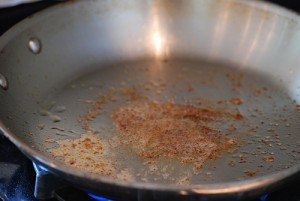 Deglazing a pan is the key to making delicious sauces and gravies for your meats and vegetables. After cooking meat or vegetables instead of scrapping all the leftover fat and dregs into a grease jar, make it into a divine sauce. Deglazing a pan is simply adding stock, lime juice, water, or some other liquid to break up and dissolve the dregs left over from sauteing, searing, or roasting. I especially like to deglaze my cast iron pans, as it helps the cast iron’s flavor–not that I eat cast iron or anything.
Deglazing a pan is the key to making delicious sauces and gravies for your meats and vegetables. After cooking meat or vegetables instead of scrapping all the leftover fat and dregs into a grease jar, make it into a divine sauce. Deglazing a pan is simply adding stock, lime juice, water, or some other liquid to break up and dissolve the dregs left over from sauteing, searing, or roasting. I especially like to deglaze my cast iron pans, as it helps the cast iron’s flavor–not that I eat cast iron or anything.
If you haven’t deglazed your pans before, now’s a good time to get started. You’ll be surprised how well you can get the junk off your pan when doing so ad also the delicious sauces you can make. So for starters, here’s how to deglaze your pots and pans and make a delicious sauce.
Deglazing Instructions
- Remove the cooked food from the pan.
- If there is a lot of extra grease, fat, or oil in the pan poor most of it out into your grease jar. Too much fat and grease in your sauce will ruin it. Consider using a strainer to keep most of the meaty dregs in the pan. If there’s a distinct line between the fats and cooking liquids, spoon off the fats and leave as much cooking liquid behind as you can.
- Immediately add your stock* or deglazing liquid to the pan, and continue to heat the pan on medium to medium-high. Once the liquid boils, reduce the heat, but keep the liquid boiling. There are two key points to remember at this point: first, you want the liquid to come to a boil to help break up the particles; second, the less liquid you use, the more flavorful your sauce will be because the dregs will concentrate a smaller volume.
- As the deglazing liquid heats up and boils use a stirring utensil to scrape off the black spots from the pan’s bottom and break up the solid particles. I recommend using a wooden scraper or spoon.
- Once you’ve broken up as much of the dregs that you can, you’re ready to make your sauce or gravy. There are a number of sauces and gravies you can make. Be creative and add your favorite spices or aromatic vegetables (such as garlic, shallots, or onions). If you want a thinner, less viscous sauce, consider pouring what you have into a pouring dish. Use a strainer if you’re anti-crunchy particles. For a thicker sauce or gravy, use cornstarch or flour to thicken it up. If you want to attempt a sauce but you’re not sure where to start, try the recipe below.
*For best flavor use beef stock, chicken stock, or vegetable stock. If you’re just going to deglaze your pan to get rid of the black spots, you’re fine using only water. Using liquid with alcoholic content can cause flames to spew if added when the pan is too hot; so if you’re using wine, add it while the pan is cooler and then heat the pan to boil.
Basic Deglazing Recipe
Ingredients
Use more or less of each ingredient to taste.
Method
- Before adding any stock to the pan, sauté the minced onion and garlic in the remaining fat until they’re semiopaque.
- Add 1 cup of broth and bring to a boil. Use a wooden scraper or spoon to break up the black leftovers in the liquid and scrape the black off the bottom of the pan.
- After you have broken up as much solid particles as you can, add the butter. This will give your sauce a nice shimmer and full taste. If you want a thicker sauce, mix 1/4 cup flour with 1/4 cup water in a separate cup until flour chunks are gone, then poor in slowly while mixing sauce. It will take a few extra minutes for the sauce to thicken.
- Salt and pepper lightly to taste. You can add other seasonings if you like.
- Pour the sauce over the sautéed food, serve, and enjoy!
I was looking for a simple way to deglaze pans. Finally, I found it here and also love deglazing instructions. I hope It will be a very easy method. I am very grateful. Thanks:)
Until now, I have never heard of deglazing a fry pan. Although I have learned this process from my mother, without knowing it is a named process. However, flavored stocks have never been used, only water. Thank you for sharing. I am going to try this process, and cannot wait to enjoy the enhanced flavor of my gravy.
Awesome! Yeah, simple sauces from the deglazed bits are a quick addition to meals.